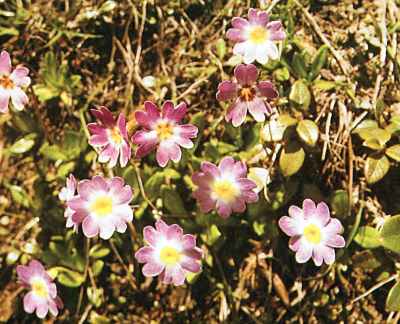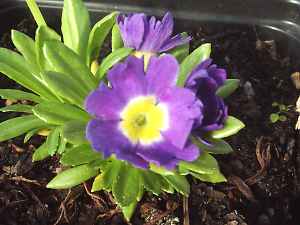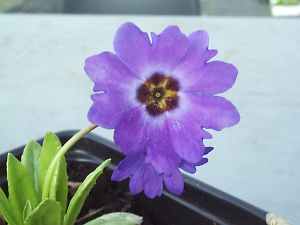 |
Plant Portrait : Primula dickieana |
| Home Recommend This Site To A Friend |
|
by Udai C. Pradhan, Alastair McKelvie and Fred Carrie 
Udai C.Pradhan During visits to north-eastern Sikkim with my colleague and co-author, Sonam Lachungpa, while recording rhododendron species for our book 'Sikkim Himalayan Rhododendrons', we were in a spot called Yakchey. This spot a few km north of Lachung has a fine colony of Rhododendron niveum (smoky blue flowers). Opposite this habitat is marshy land where some exceptionally lovely R. ciliatum used to exist. It was while photographing R. ciliatum that I first spotted what to me looked like Primula dickieana. Just to make sure, I immediately sketched it in my scrapbook and also took some slides of the plant . This was away back in 1986 when the eastern half of Sikkim was still out of bounds for foreign visitors. In May 1995, while giving a slide talk on Sikkim Himalayan flowers to an enthusiastic group of plants-men from the Scottish Rock Garden Club I happened to mention this plant to Alastair McKelvie and other members of the Group that also included my old friend Heather Salzen who had visited us with Oleg Polunin in the early 1980's. I then showed them a slide of this plant and it transpired that Heather and Alastair had spotted what was probably the same group of plants during their visit to Lachung. Addendum (Alastair McKelvie) The above note from Udai Pradhan is of interest because of the context of the find. On a visit to Sikkim in May 1995 by a group of plants-people ( not a SRGC Group as stated by Udai) we visited Lachung in north east Sikkim, an area where access is still difficult and photography forbidden (we were searched for cameras!). Heather and I spotted this group of magnificent primulas as mentioned by Udai. The photo above does not do justice to the wide colour variation shown by the colony, from pale yellow through to deep pink. 'An Enumeration of the Flowering Plants of Nepal' suggested it might be a form of P. dickleana which is normally yellow. This was further supported by Udai's opinion and by references I found on my return home in the AGS Bulletin by Kingdon Ward (1938, 6, 300) who found P. dickieana in Assam in exactly the same conditions as we saw in Sikkim, wet peaty pastures trampled by yaks. Ahead of his time as an 'environmentalist', Kingdon Ward pointed out that ' the presence of yak undoubtedly stimulates this primula and we have the curious spectacle of the rhododendron scrub being cut and burnt by man and the pasture being rapidly replaced by a single species of primula, useless for cattle; an example of succession not perhaps dreamed of by our ecologists'. More positive identification came from an article by Lowe and Smith (AGS Bulletin 1979,47,38) whose detailed drawing agreed closely with our Sikkimese plant. They described the flower colour as ranging from white to yellow, pink, purple or red. Key diagnostic features are the glandular hairs of the corolla and throat and the glandular depressions on the underside of the leaves. It would be interesting to know if anyone grows this pink/red form at present. It would seem to need cool moist shade during the growing season and a fairly dry winter. For anyone interested in going to Sikkim, particularly the 'forbidden' north-east corner near the Tibet border, treks are available through Chandertal Tours and Sikkim World Expeditions. Udai Pradhan is the founder Editor of the Himalayan Plant Journal of which four issues were produced before the agitation for Gorkhaland from 1985-1989 forced closure. He wishes to revive the HPJ once again and seeks support from plant lovers for subscriptions and articles. Around 3000 subscribers would see this Journal back into circulation again. Anyone interested should contact Mr Udai C. Pradhan, Himalayan Plant Journal, Primulaceae Books, P.O. Box 6, Abhijit Villa, Kalimpong 734301, Darjeeling, Gorkha Hill Council, West Bengal, India.Further notes (Fred Carrie) The above article was first published in the January 1996 edition of the SRGC Journal. During his trip in 1995, Alastair managed to find a few seeds of this primula which he germinated. A few of these were passed onto me for growing on in the ‘Primula Friendly’ conditions here at Tough in Aberdeenshire. Four of these have survived but have been very slow. They flowered for the first time in May 2000. Luckily two of the plants are pin eyed and two are thrum. The colours of the pin and thrum flowers are quite different, see below (although four plants is hardly a representative sample) . They have been hand pollinated in the hope of getting some new seed. This plant has been lost to cultivation on several occasions and it would be interesting to know if anyone else out there still has plants of this lovely species.
^ back to the top ^ |

